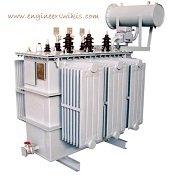
Overtemperature protection is crucial for safeguarding transformers from excessive heat that can lead to insulation degradation, reduced lifespan, or even catastrophic failures. Transformers can experience overtemperature conditions due to factors such as overload, ambient temperature, cooling system failure, or insulation deterioration. Methods and devices used for overtemperature protection of transformers are as follows:
Thermal Relays:
Thermal relays, also known as thermal overload relays, commonly used for overtemperature protection. These relays typically embedded within the transformer windings or attached to the oil-filled conservator tank. Thermal relays monitor the temperature of the transformer by using bi-metallic elements or temperature sensors. When the temperature exceeds predetermined threshold, the thermal relay initiates protective actions, such as tripping circuit breakers or activating alarms.
Temperature Sensors:
Temperature sensors, such as resistance temperature detectors (RTDs) or thermocouples, installed in critical areas of the transformer, such as the windings or oil. These sensors provide continuous temperature monitoring and feedback to protective devices or control systems. If the temperature rises above a preset limit, the protective devices can activate appropriate measures to mitigate the overtemperature condition.
Cooling Systems and Fans:
Cooling systems play a vital role in maintaining the operating temperature of transformers within acceptable limits. Forced air cooling, oil cooling, or liquid cooling systems employed to dissipate heat generated by the transformer. Temperature sensors often integrated into the cooling system to monitor the temperature of the cooling medium. If the temperature exceeds a certain threshold, the protective system can activate additional cooling measures or issue alarms.
Alarm Systems and Monitoring:
Overtemperature protection may include the use of alarm systems and monitoring devices. These systems provide visual or audible alarms when the temperature exceeds a predefined limit. Additionally, they can transmit signals to a centralized control room or a supervisory control and data acquisition (SCADA) system, enabling remote monitoring and timely intervention in case of overtemperature events.
Protective Relays:
Protective relays, such as differential relays or transformer protection relays, can also incorporate overtemperature protection as one of their functions. These relays continuously monitor various parameters, including temperature, and initiate protective actions when predetermined limits are exceeded. They can coordinate with other protective devices and provide comprehensive protection for the transformer.
Thermal Imaging:
Thermal imaging cameras or infrared thermography techniques can be used to detect abnormal temperature patterns or hotspots on the transformer’s surface. Regular thermal inspections can help identify potential overtemperature conditions and enable proactive maintenance or corrective actions.
Overtemperature protection should be complemented by proper transformer design, adequate ventilation, and regular maintenance practices. The specific methods and devices employed for overtemperature protection depend on the transformer’s design, rating, and application requirements. Careful consideration of these factors, along with adherence to industry standards and guidelines, ensures effective overtemperature protection and enhances the reliability and longevity of transformers.
